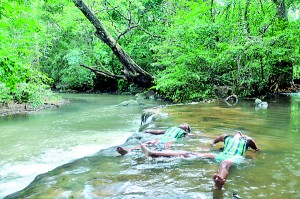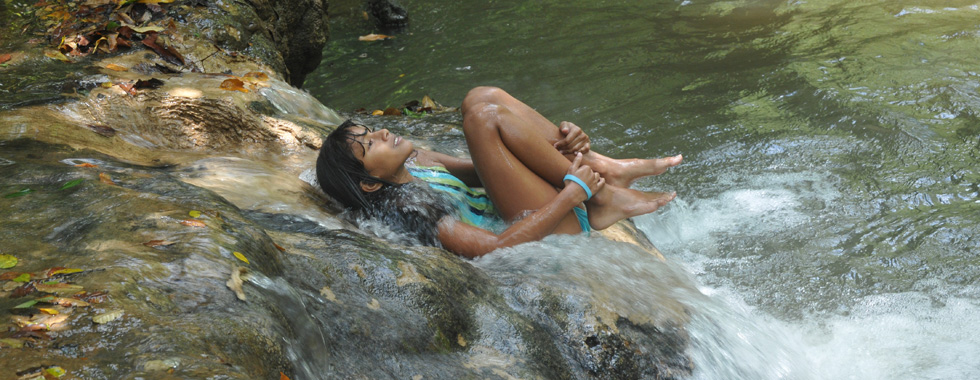A place ‘Jane and Tarzan’ would call their home
View(s):Kumudini Hettiarachchi enjoys nature’s blessings at an eco-friendly hideaway by the
flowing Dehigaha-ela
Not down a long and winding corridor, but up a tree are we led to our room!
In the absolute stillness of a Dry Zone jungle morning, the colourful procession that leads us to our accommodation in a large Damba tree is a cloud of gossamer-winged butterflies, hundreds of them not only flitting about but also settling on our very bodies. The only sound that provides a constant murmur of music in the background that soothes the weary soul is the meandering Dehigaha-ela.

The Damba tree-house
Having arrived along an off-the-beaten track through elephant country, a sudden turn brings us to a place where time stands still. On the way, the presence of elephants is obvious – fresh dung along the track and the electric fence which attempts to contain them in the Sigiriya sanctuary downed at several spots. Low-flying peacocks perch on branches, while the vehicle has to make an unscheduled halt for a teeny-weeny star tortoise to waddle across the track at its own pace.
Away from the madding crowds of the towns and cities and also the rat race of work, school, tuition, extracurricular activities and associated worries, suddenly a vista of peace and tranquillity opens out, fringed by forest and grassland (iluk-thenna), with a pond dotted with pink-tinted nelum and a few manel greeting the visitor, uplifting the spirits.
Aptly-named ‘Back of Beyond’, this is the ‘Dehigaha-ela’ eco-retreat 7km from Sigiriya near Alakolawewa village, in all its beauty on a Saturday morning in March. The rains have been heavy the previous week, leaving in their refreshing and nourishing wake a jungle of different hues and shades of green.
But where is the retreat? It is right there nestling amidst seven acres not only hidden among the trees and foliage but blending in as well.
Feeling the need to establish a retreat close to nature, Dehigaha-ela opened its village-type doors just about three years ago in May 2010, says a spokesperson, explaining that the rustic “back to basics” but comfortable accommodation consists of two tree houses, up Damba and Kon trees respectively, and five cottages including four hugging massive rock-boulders.
The sparse cottages take their names from the trees closest to them whose spreading branches form part of the roof. The attached

A cool dip in the ela
bathrooms are open to the surrounding foliage and sky above, with one even having a peella-like shower, spouting icy cold water, and another harbouring a bird’s nest in a small tree within the toilet-yard.
Reiterating the philosophy on which not only the Dehigaha-ela retreat but all eight other ‘Back of Beyond’ hideaways scattered across the country have been set up, the spokesperson says, “We acknowledge we are intruding…but we hope we touch our natural and social environment so minimally that it feels nothing but a gentle touch…”
The “minimally-invasive” dwellings have been built after studying animal movements to avoid conflicts and enhance co-existence, he adds.
This is just what designer, K.D. Laxman has achieved, using traditional material as well as traditional architecture. Mud and cow-dung floors, iluk or coconut frond-thatched roofs, grown and not forest timber and doors and windows “recycled” from demolished houses.
With the retreat having both a Dry Zone forest and a riverine forest on its doorstep, there is no lack of insect, reptile, amphibian, bird or mammal.
As the sun rises in all its glory, dispelling and diffusing the mantle of heavy mist which has covered the retreat the night before, the butterflies begin their dance towards Samanala Kanda (Sri Pada).
Yes, this is the season, smiles the spokesperson, while we look in wonderment not only at these insects but also at the sparkling-patches of dewdrop diamonds on the ground. Early too begins the sopranos, altos, tenors and basses of the birds trying to outdo each other while on a stark tree a little way off the majestic Crested-hawk Eagle announces to the world that it is the master of all it surveys. A few trees away, is its stick eyrie straddling the meeting-point of two massive branches.

The ‘lobby’ in all its simplicity
More than 100 species of birds including the Orange-headed Ground Thrush, Black-headed Cuckooshrike, Paradise Flycatcher, Jerdon’s Leafbird, White-rumped Shama dubbed “our nightingale”, Brown Fish Owl, Drunken Sailor (Fantail Flycatcher), Hornbills and Minivets have been spotted by visitors at different times, while the animals which roam the retreat include the elephant, the leopard, the sambhur, the spotted and mouse deer, the diya balla (otter), the fishing cat, the rusty spotted cat, the civet, the mongoose and the species of moneys – the grey languor, the torque monkey, the purple-faced leaf monkey and the big-eyed loris.
The days are long and lazy and time passes slowly. As night descends fast, like in the jungle, without hardly any twilight, the orchestra of the cicadas starts up, loud and soft, as if the unseen baton of their choral director is pointing this and that way. The fireflies, meanwhile, begin to compete at showing off their lights against the twinkling of stars in the inky blackness of a cloudless night.
The jewel in the crown of this retreat is, of course, as its name proclaims, the two-km Dehigaha-ela, bubbling out of a spring, gurgling over rocks and dropping down in a foamy froth, to join the Kiri Oya and ultimately flow into the Minneriya tank.
There are many perfect spots for bathing, natural swimming pools that beckon the visitor, who will also get a “fish-nibble” massage all over the body. A child’s ‘bathing seat’, a natural Jacuzzi and an underwater garden are all part of the experience.
While bird watching, nature walks, stream baths, up-stream hiking, cycling can fill up the day, some of the other natural wonders include a massive pus-wela and an atamba tree with a huge girth of four metres (13 feet). The area is also replete with history, with folklore indicating that the boat of King Mahasen would park in a rock pool of the Dehigaha-ela after which the King would make his way to the palace on the Nuwaragala mountain.
From here visitors could also go on excursions to Sigiriya, Pidurangala, Nuwaragala, Kaludiya Pokuna, Dambulla and Menikdena; the wildlife parks of Minneriya, Kaudulla and Hurulu Wewa and the eco-park at Habarana.
The efficient yet unobtrusive staff prepares both Sri Lankan and western cuisine but to truly savour the retreat, rice and curry can be eaten off a nelum kole (leaf) placed on a small woven basket. The close-to-nature concept is further propagated by the staff offering filtered water from a well, gently discouraging plastic bottles of water and the plastic waste that follows.
Many are the visitors from all over the world including Sri Lanka who have waxed eloquent over their stay at Dehigaha-ela…… “a beautiful wild hideaway”, “our own slice of jungle”, “back to nature’s simplicity”, “magical exciting adventure” and “firefly festival” are some comments but my favourite is the compliment simply signed by ‘Tarzan & Jane’.
(Information about Dehigaha-ela retreat may be accessed at www.backofbeyond.lk or obtained from e-mail: backofbeyondpidu@gmail.com)

Follow @timesonlinelk
comments powered by Disqus



















